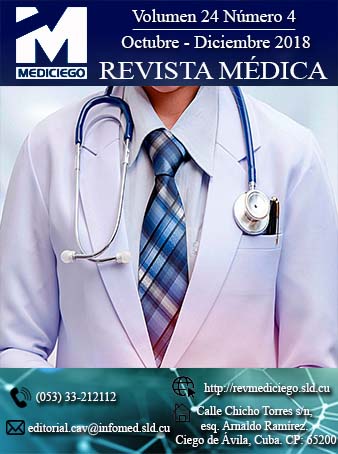Educational intervention on pulmonary tuberculosis in the Provincial Penitentiary Establishment of Ciego de Ávila
Abstract
Introduction: pulmonary tuberculosis is the most important transmissible disease in the history of mankind. Despite efforts to control and eradicate it, the numbers of sick and deceased are alarming.
Objective: to evaluate the utility of an educational intervention program to modify the level of knowledge about pulmonary tuberculosis in the penal population of the Provincial Penitentiary Establishment of Ciego de Ávila.
Method: a pre-experimental study (before-after) was carried out between January and December 2017. The universe was constituted by the 1 000 inmates of the institution. From them, 39 were selected through non-probabilistic sampling. In the first stage, according to critical cases, 13 internal health promoters were selected, one from each detachment, and these, in a second stage, in cascade, elected two key informants. In the analysis of the socio-demographic variables were used the mean and the standard deviation, and to measure the response of the intervention, the statistical tests of McNemar and the Wilcoxon signed-rank test.
Results: more than half of the inmates had a higher average educational level (69,23 %). The average age was 37,70 years. The level of global knowledge increased 2,56 % with an adequate level before the intervention until 87,18 % after being applied, with significant differences. All participants said that the intervention was pleasant and instructive.
Conclusions: the usefulness of the educational intervention was demonstrated by improving the level of knowledge about pulmonary tuberculosis in the selected inmatesDownloads
Published
How to Cite
Issue
Section
License
Those authors who have publications with this journal accept the following terms of the License CC Attribution-NonCommercial 4.0 International (CC BY-NC 4.0):
You are free to:
- Share — copy and redistribute the material in any medium or format
- Adapt — remix, transform, and build upon the material
The licensor cannot revoke these freedoms as long as you follow the license terms.
Under the following terms:
- Attribution — You must give appropriate credit , provide a link to the license, and indicate if changes were made . You may do so in any reasonable manner, but not in any way that suggests the licensor endorses you or your use.
- NonCommercial — You may not use the material for commercial purposes .
- No additional restrictions — You may not apply legal terms or technological measures that legally restrict others from doing anything the license permits.
The journal is not responsible for the opinions and concepts expressed in the works, which are the exclusive responsibility of the authors. The Editor, with the assistance of the Editorial Committee, reserves the right to suggest or request advisable or necessary modifications. Original scientific works are accepted for publication, as are the results of research of interest that have not been published or sent to another journal for the same purpose.
The mention of trademarks of specific equipment, instruments or materials is for identification purposes, and there is no promotional commitment in relation to them, neither by the authors nor by the editor.

























